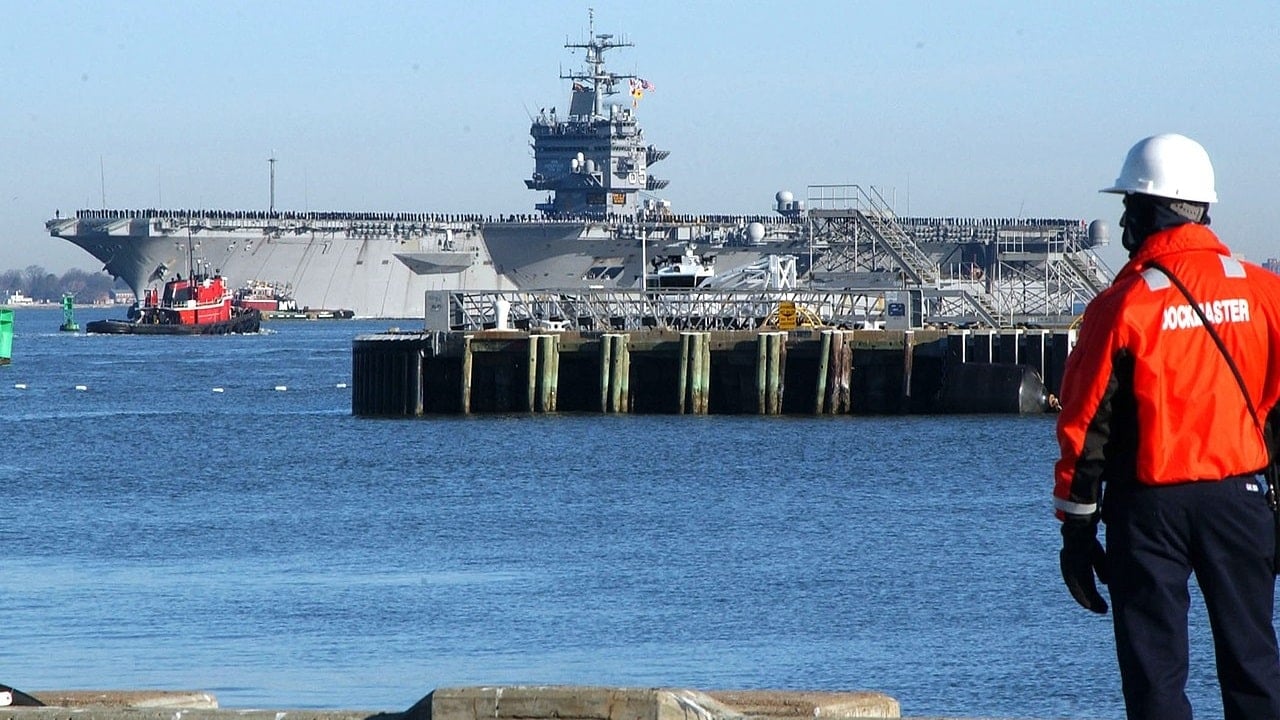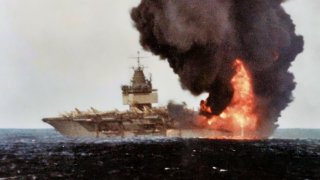'Flight Deck Explosion' Nearly Destroyed a Navy Nuclear Aircraft Carrier
In 1969, the USS Enterprise, the world's first nuclear-powered aircraft carrier, suffered a catastrophic accident off the coast of Pearl Harbor while preparing for its fourth deployment to Vietnam.
What You Need to Know: In 1969, the USS Enterprise, the world's first nuclear-powered aircraft carrier, suffered a catastrophic accident off the coast of Pearl Harbor while preparing for its fourth deployment to Vietnam. An overheated Zuni rocket warhead, caused by exhaust from a nearby aircraft starter unit, accidentally fired and triggered a chain reaction of explosions on the flight deck.

-The disaster killed 28 sailors, injured hundreds, and destroyed 15 aircraft, resulting in damage costing approximately $1 billion when adjusted for inflation.
-The tragedy highlighted critical safety oversights and led to significant improvements in naval firefighting procedures. Despite the incident, the Enterprise was repaired and continued to serve until its decommissioning in 2012.
USS Enterprise Incident: An Aircraft Carrier Was Nearly Lost
USS Enterprise suffered a deadly peacetime disaster while gearing up for its fourth and final deployment to Vietnam in 1969. An unfortunate accident led to the launching of a Zuni rocket onboard, igniting a domino effect of explosions. Twenty-eight sailors died in the incident, hundreds more were injured and fifteen airframes were destroyed. Ultimately, the explosion caused damage that would cost roughly $1 billion when adjusted for inflation in the modern era.
As the world’s first nuclear-powered aircraft carrier to ever sail the seas, the USS Enterprise was truly cutting edge when first commissioned in the late 1950’s. The hefty ship, nicknamed “Big E” like her predecessor, featured two nuclear A2W reactors. While she wasn’t the first supercarrier to set sail, the USS Enterprise was one of the largest ships of her kind to be constructed. Measuring 1,122 feet long and displacing nearly 95,000 tons, she is the longest warship ever built.
Over her extensive service history, Enterprise achieved several milestones, including the first aircraft launch with a launch bar. Although the infamous 1969 fire onboard the Enterprise was devastating, it did lead to improvements in firefighting concepts for future vessels.

What Happened?
The aircraft carrier USS Enterprise was operating off the coast of Pearl Harbor, Hawaii when the lethal incident occurred. A junior airman had recognized that a huffer (MD-3A) aircraft starter unit was blowing hot exhaust directly onto the warhead of a Zuni rocket, however, his warnings of the deadly combination were either not heard or misunderstood. Since the warhead of the rocket could be set off by reaching 358 degrees Fahrenheit, the huffer’s exhaust temperature of more than 500 degrees Fahrenheit was certainly high enough to do the trick.
Once the first Zuni rocket exploded, three others followed suit resulting in a massive hole in the flight deck. Although the skipper of the carrier was able to steer the ship so that the flames and smoke were flown off the flight deck, a bomb positioned in a Phantom airframe exploded. Ultimately, eighteen explosions ensued overall and a 6,000-gallon fuel tank onboard was ruptured. The hefty fireball caused by these explosions was extensive and destroyed an EKA-3B tanker, eight F-4 Phantoms, and six A-7 Corsairs.
According to the Naval History and Heritage Command, The MD-3A starter unit driver, “Airman John R. Webster, was killed instantly by the first blast; the radar intercept officer of F-4J No. 105, LTJF Buddy Pyeatt, was killed in the fire; and the pilot of the aircraft, LTJF Jim Berry died as a result of his burns months later. Many of those who died were killed by the second explosion as they rushed to fight the fire. In a subsequent investigation into the incident, the Navy found that “A preponderance of those killed were flight deck maintenance personnel of VF-96 and VF-92 and from the ship’s V1 Division.”
Following the fire, Enterprise underwent extensive repairs at Pearl Harbor before continuing her deployment to aid U.S. troops in Vietnam. The legendary aircraft carrier eventually decommissioned in 2012.
About the Author: Maya Carlin
Maya Carlin, National Security Writer with The National Interest, is an analyst with the Center for Security Policy and a former Anna Sobol Levy Fellow at IDC Herzliya in Israel. She has by-lines in many publications, including The National Interest, Jerusalem Post, and Times of Israel. You can follow her on Twitter: @MayaCarlin.
Image Credit: Creative Commons and/or Shutterstock.


